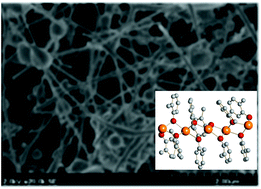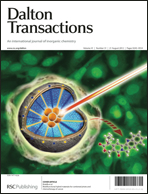A series of tin(II) amide alkoxides ([(OR)Sn(NMe2)]n) and tin(II) alkoxides ([Sn(OR)2]n) were investigated as precursors for the production of tin oxide (SnOx) nanowires. The precursors were synthesized from the metathesis of tin dimethylamide ([Sn(NMe2)2]2) and a series of aryl alcohols {H-OAr = H-OC6H4(R)-2: R = CH3 (H-oMP), CH(CH3)2 (H-oPP), C(CH3)3 (H-oBP)] or [H-OC6H3(R)2-2,6: R = CH3 (H-DMP), CH(CH3)2 (H-DIP), C(CH3)3 (H-DBP)]}. The 1 : 1 products were all identified as the dinuclear species [(OAr)Sn(μ-NMe2)]2 where OAr = oMP (1), oPP (2), oBP (3), DMP (4), DIP (5), DBP (6). The 1 : 2 products were identified as either a polymer ([Sn(μ-OAr)2]∞ (where OAr = oMP (7), oPP (8)), dinuclear [(OAr)Sn(μ-OAr)]2 (where OAr = oBP (9), DMP (10) or DIP/HNMe2 (11)), or mononuclear [Sn(DBP)2] (12) complexes. These novel families of compounds (heteroleptic 1–6, and homoleptic 7–12) were evaluated for the production of SnOx nanowires using solution precipitation (SPPT; oleylamine/octadecene solvent system) or electrospinning (ES; THF solvent) processing conditions. The SPPT route that employed the heteroleptic precursors yielded mixed phases of Sno : romarchite [1 (100 : 0); 2 (80 : 20); 3 (68 : 32); 4 (86 : 14); 5 (66 : 35); 6 (88 : 12)], with a variety of spherical sized particles [1 (350–900 nm); 2 (150–1200 nm); 3 (250–950 nm); 4 (20–180 nm); 5 (80–400 nm); 6 (40–200 nm)]. For the homoleptic precursors, similar phased [7 (80 : 20); 8 (23 : 77); 9 (15 : 85); 10 (34 : 66); 11 (77 : 23); 12 (77 : 23)] spherical nanodots were isolated [7 (50–300 nm); 8: (irregular); 10 (200–800 nm); 11 (50–150 nm); 12 (50–450 nm)], except for 9 which formed polycrystalline rods [Sno : romarchite (15 : 85)] with aspect ratios >100. From ES routes, the heteroleptic species were found to form ‘tadpole-shaped’ materials whereas the homoleptic species formed electrosprayed nanodots. The one exception noted was for 7, where, without use of a polymer matrix, nanowires of Sno, decorated with micron sized ‘balls’ were observed. Due to the small amount of material generated, PXRD patterns were inconclusive to the identity of the generated material; however, cyclic voltammetry on select samples was used to tentatively identify the final Sno (from 7) with the other sample identified as SnOx (from 1).


 Please wait while we load your content...
Please wait while we load your content...